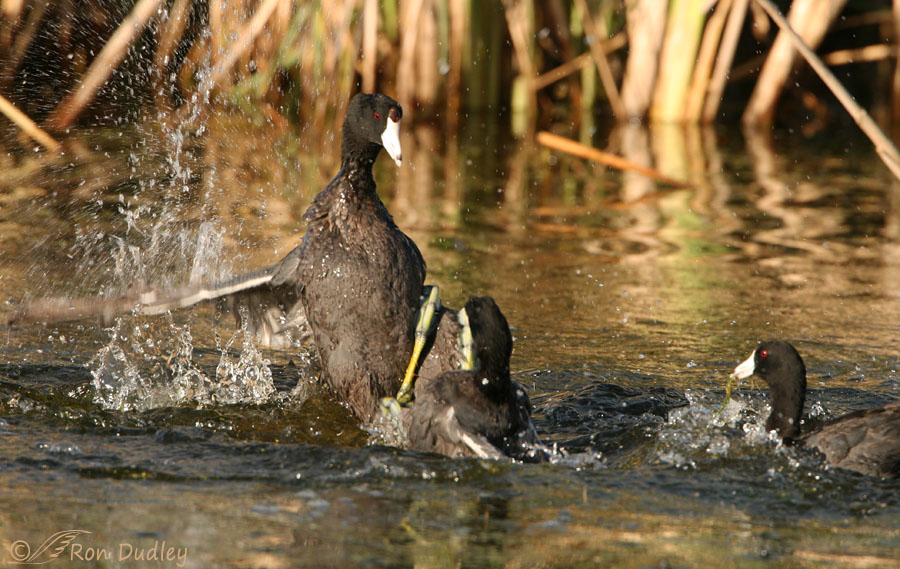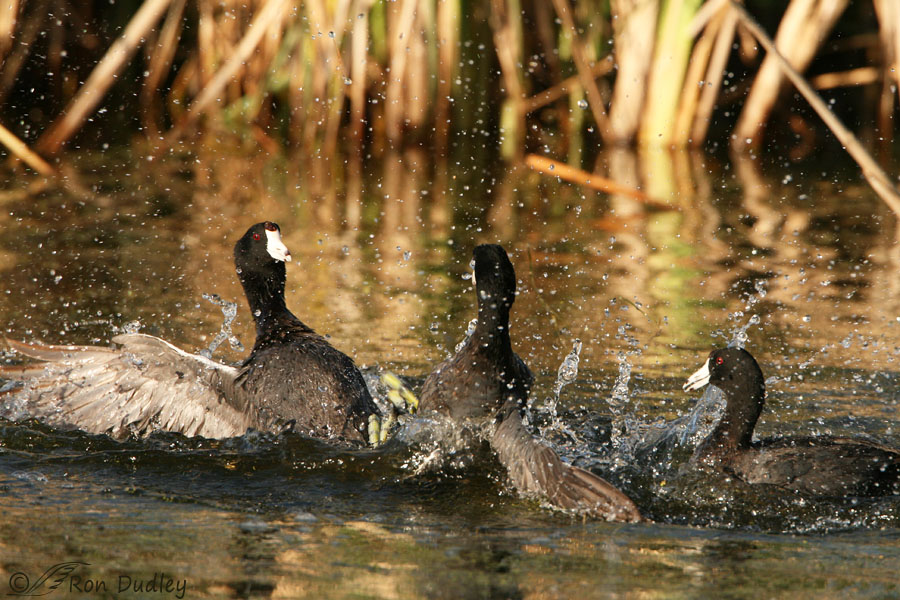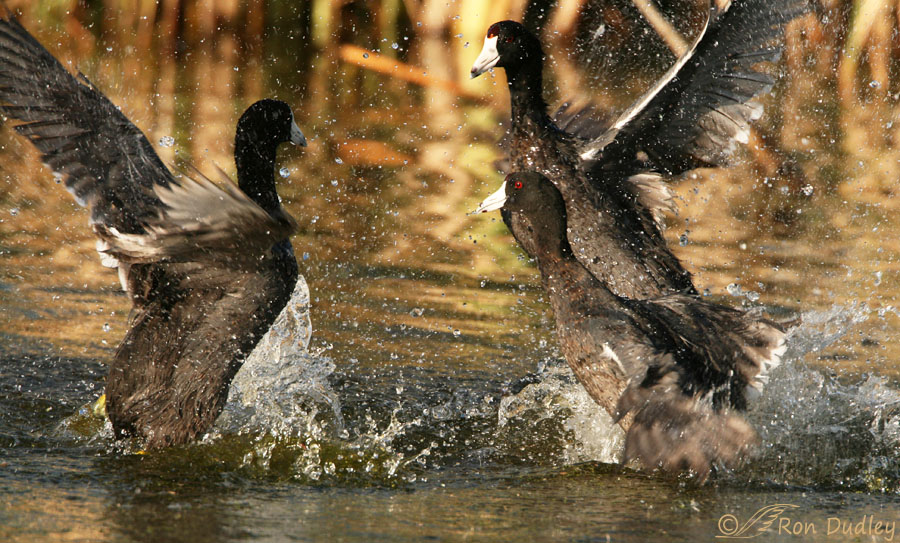These photos of brawling coots are among the very first I ever took with my brand new 500mm lens over eleven years ago, on June 18, 2007.
And I was also using my first DSLR camera, a Canon Rebel XTi that only took 10 MP photos. It was a tiny camera for a DSLR but it was relatively cheap and about all I could afford given the huge investment I’d recently made in that very expensive lens. I remember asking the guy at the camera store if that camera would work with my 500 and still maintain autofocus and I’ll never forget his response – “Yes, it’ll work but that little camera will look pretty silly on the end of that monster lens”.
I had a lot to learn…

1/500, f/8, ISO 400, Canon Rebel XTi, Canon EF 500mm f/4L IS USM + EF 1.4 Extender, not baited, set up or called in
I found the fighting coots on Glover Pond near Farmington Bay. I didn’t know what I was doing so I just fired away and hoped for the best. Coots often fight with their feet…

1/800, f/8, ISO 400, Canon Rebel XTi, Canon EF 500mm f/4L IS USM + EF 1.4 Extender, not baited, set up or called in
while laying on their backs on the water and these guys were pretty vicious about it. Most of the time the coot on the right was just an onlooker but eventually…

1/800, f/8, ISO 400, Canon Rebel XTi, Canon EF 500mm f/4L IS USM + EF 1.4 Extender, not baited, set up or called in
it couldn’t resist joining in on the brouhaha.
Like most bird fights this one was highly entertaining but I’m not posting the photos because I’m particularly proud of them. I just made too many beginner’s mistakes, including but not limited to the following:
- Even though I’d been warned by a mentor that I’d regret it if I insisting on shooting in jpeg rather than RAW I was too intimidated by having to learn all that processing technique to make the switch so these photos were taken in jpeg. As a result in images like these with bright whites and deep blacks I couldn’t bring out any detail in some of the blacks without blowing out the whites.
- I’d read once that f/8 was the “sweet spot” for sharpness with my new lens so in those days I was shooting almost everything at that aperture. That was a mistake related to the third item below.
- A shutter speed of 1/500 – 1/800 simply isn’t fast enough for fast action like this (for example notice the soft feet in the second photo). At this point in my photography learning curve I just wasn’t adept enough at changing settings without missing too much action. Besides, I didn’t really know what to do anyway, or if I did I had to think about it for far too long.
- As close as I was to these birds I should have removed my teleconverter because I kept clipping or cutting off body parts. But as slow and awkward I was back then at swapping out the tc I knew that all the fighting would be over by the time I got it done.
But despite all the flaws I still like seeing these old photos. Fights are always fun and interesting to photograph, I learned some stuff and I enjoy the memories.
Ron


Not bad at all for “beginner’s mistakes”. Makes me appreciate all the lessons learned to bring you to the level of photography you are at now.
Thank you, Lyle.
I do love my early morning visits here. They so often start my day the way I hope to end my days – learning. And marvelling.
I’m with you EC…except that these days, it might be 3:30 in the morning and I might be catching up for several days…DARGH!
Yup. I hope your pain backs off soon. Chronic pain/illness outsuck Dyson.
As another member of the chronic pain/invisible illness club, I heartily agree — it outsucks Dyson, Hoover, Dirt Devil, and the “vacuum” of space!!!
I’m lucky in that regard, EC. I often start my day learning as I read comments from readers and since I write most of my posts at night I’m usually learning then too.
I love the coot fighting sequence. It is a much under-appreciated bird. Like robins, killdeer and some other species, its commons means that people often don’t look closely and therefore, miss a lot. I once did a painting of a coot and was told it was wrong. I showed a red patch above the white on the forehead, but was told that doesn’t belong there. I told that person to go look closely at coots again. Because they’re “just coots” he had only given them a quick glance and never saw that feature before.Each year I give my ornithology students a detailed description of an American Robin, except that I don’t mention the red breast. Without that detail, very few students have ever known what bird I was talking about. Just too common, and thus, ignored.
Dan, my story isn’t the same as yours but what you said brought back a memory. In my college Ornithology class the final lab exam was a practical. We had to go from lab specimen to lab specimen and identify the species or answer other questions about them. One of them was a coot but it had a deformity (can’t remember what it was but it might have been related to those unique feet) and it threw all of us. No one got it right.
OK, I GET that you see all the nits you picked, but even after you pointed them out, I don’t see ’em…says the photographical luddite here 😉 All I see is some really cool bird/coot behavior shots. Maybe it’s the pain killers OR that I’ll probably never morph into a photographer. But as a writer, I LOVE your description of “brawling coots!” Even in context of most bird kerfluffles that don’t last more than a couple of seconds, that’s an excellent description!
Interesting from the perspective of a classroom teacher that you say, “I don’t learn nearly as well in a classroom environment as I do one on one.” I’ll bet, given that reality, that you provided as much one-on-one teaching as you could fit into any given class! And that’s one of many factors that makes you an excellent teacher, even with us luddites who are here for the feathers and the history. LOL!
“Interesting from the perspective of a classroom teacher that you say, “I don’t learn nearly as well in a classroom environment as I do one on one.” ”
I wondered if someone would pick up on that, Laura.
I believe that most, perhaps even all, learners learn more quickly and more effectively in a one on one situation than in a classroom situation. Sadly it just isn’t possible on a large scale in public education. Hell in some years I had over 200 kids in my classes though it was usually somewhere in the 170+ range.
Man, your class size/total for the year, was way bigger than mine, (100 or less with 20 or less in 5 classes) had forgotten you guys in public education have to deal with. You deserve tons of credit, thanks, exemplary term of service and liking it is a term of distinction.
I have 185 kids with 37/class — makes science lab groups funfunfun! At least I’m not PE — they have 54 per class.
Can I hear a YIKES!! EGADS! Not even my college courses had that many students!
Remember, this is UTAH. We like to have kids, tons of them, but we don’t like to pay for their education…
Shock and horror. My class sizes were rarely over 30. And 35 one year caused an almighty kerfuffle.
If I knew you were a teacher I’d forgotten it, EC. What did you teach? Or were you referring to when you were a student?
Definitely a student. In my training (rather than teaching) career classes didn’t go over a dozen. Which was a generous sufficiency.
Fantastic post! Love the coots and love learning about your “learning curve” – as I am going through one now. It’s so very inspiring to see how accomplished you have become. Thanks.
That learning curve never stops, Joanne. Thanks.
I like your photos, but like even more the explanations! Unfortunately, I still make some of those mistakes. Besides the excellent shots you present each day Ron, I really appreciate the teacher in you and your willingness to present your mistakes as a lesson to us all. I probably would have been so captivated by the fight I either wouldn’t have shot much or would have run out of battery shooting. Great post, many thanks!
I still make some of them too, Dick – including having my tc on or off at the wrong time.
Ron, I get heckled by my fellow birders due to my photographing/watching the coots. I will point out this blog, maybe there will be some new “cooters” in the future. Speaking of fighting birds, I read this about the carrying pigeons of WW1. later jake
https://www.wkrn.com/news/weekend-extra/100th-anniversary-of-carrier-pigeon-s-heroic-flight-to-save-us-troops-during-wwi/1500487332
Jake, I used to read about those war pigeons, including Wilson, back when I was a kid raising pigeons.
Coots are birds and if it has feathers I’ll photograph it.
Good morning Ron. Oh, the unappreciated unloved lowly and often ignored Coots. When all our winter ducks are here I find myself shooting pictures of them all, but most often ignoring the Coots. Interesting lessons in photography Ron – appreciate the information. I am laughing picturing that little camera with that huge humongous lens. I have taken action photos of fighting Greylag Geese and it definitely was entertaining and loud. Hope you are feeling better.
Everett Sanborn
Prescott Arizona
Everett, I like photographing coots but even I ignore them much too often.
Yeah, that camera on my lens did look pretty silly. But it worked and that’s the main thing – to hell with appearances!
I’ve never gotten to see Coots fight, even though I’ve seen the birds in person (including in the winter in our park when we have a pond). I did not notice the soft feet until I read your comment about them. I’m still impressed that you were able to capture the fight as well as you did. I understand completely about being slow in accomplishing tasks like removing the teleconverter…
Susan, coots are notoriously pugilistic so keep your eyes open for it!
For these shots I was actually shooting from a tripod instead of my pickup so one of my fears was dropping my tc in the rush to remove it.
WOW! Still caught more of the action than with no camera AND as you said – a learning experience! I’m still in the JPEG camp – just don’t do enough of it and HATE sitting at the computer for any length of time – enough of a challenge working with my D7200…. I’m a “show me” don’t tell me person when it comes to learning for sure! Glad you kept the photo’s as a reminder of how far you’ve come and they are cool shots…….;)
“I’m a “show me” don’t tell me person when it comes to learning”
That’s a good way of putting it, Judy. I was blown away by how fast my learning occurred in the “one on one” situation when compared to how long I struggled to make little progress before.
Given the intensity of coots when they go at it, I’m glad this didn’t turn into a “cootastrophe.” I’m happy to see coots whenever or however you post about them. And trust me, Ron, I’m right with ya on the learning curve thing, be it camera or classroom,
Believe me, I’ve had my share of cootastrophes, Marty.
Haven’t we all? 😉 They come more and more often now that I’m entering the “old coot” phase of life.
Neat set of photos. I was quite surprised the first time I saw Coots in fighting mode…they had simply been swimming about peacefully and wham…water was flying everywhere! I am very impressed with your learning curve; it shows perseverance pays off. All of your readers greatly appreciate the beauty you give us. I can relate to each of your ‘beginner’s mistakes’! 😂 I started with a Canon SX50 HS a few years ago, then got a Rebel T6s and recently added the 2nd edition of the 100-400 lens. I like the combo and given the expense angle will probably stay at this level since my photos are for me and what I post on my facebook page for a few friends. I only shoot in jpeg and am seeing that I HAVE to switch to raw but I dread the learning process! I guess the winter semester at the local tech college may have an ‘oldster’ in one of their photography classes…I’ve been putting it off far too long.
“I only shoot in jpeg and am seeing that I HAVE to switch to raw but I dread the learning process!”
So did I, Kathy – big time! At first my learning progression was extremely slow but what eventually saved my bacon was finding a knowledgeable friend who was willing to sit down with me at the computer and teach me one on one. That separates all the wheat from the chaff and makes learning much easier, quicker and more effective. And believe me there’s a lot of chaff!
Looking back, if I couldn’t find a friend who was willing to teach me I’d actually pay someone else (or pay the friend) to come to my home and teach me one on one. I should have done it months before because I have all those early jpeg shots that I can’t do much with. I don’t learn nearly as well in a classroom environment as I do one on one.
I hate it when I find an image in my organizer that I want to process for a post or some other use and discover it was taken in jpeg!
Thanks for the pictures, and for the explanations. I simply love the phrase “brawling coots”! I suspect that this may be the first instance of that particular phrase appearing in print. But then, given their pugilistic tendencies, maybe not! Anyway, I wish I had been there to see it. 🙂
“I simply love the phrase “brawling coots”!”
Then I’m glad I included it, Alison. That was a last-minute edit just before I published the post.